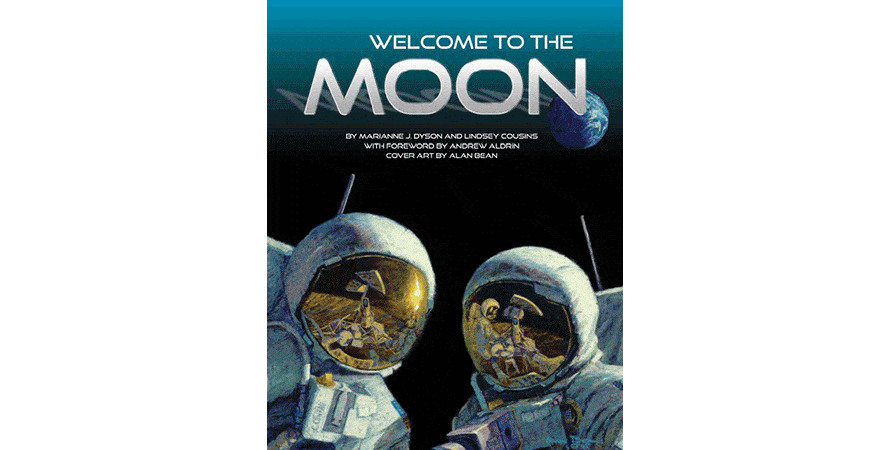Category: Children’s Books
Reviewed by: Peter Spasov
Title: Welcome to the Moon
Author: Marianne Dyson
Illustrator: Lindsey Cousens, Alan Bean
NSS Amazon link for this book
Ages: Middle School
Format: Paperback/Kindle
Pages: 97
Publisher: Aldrin Family Foundation
Date: June 2019
Retail Price: $19.50/$4.98
ISBN: 978-0578470153
There is no shortage of books about our nearest celestial neighbor. However, Marianne Dyson’s Welcome to the Moon is in a class of its own. Intended for middle school students, it lays out our latest lunar knowledge and tells the story of how we explored it. Then, more importantly, it discusses the ways and means to return for the long haul.
The book begins with a foreword by Andy Aldrin, President of the Aldrin Family Foundation, commemorating the Apollo program and advocating our return. “By working together, humanity can return to the Moon, this time to stay!” he states.
In the first chapter, the reader learns about our neighbor’s origin, geological features, orbital characteristics, and how it interacts with our own planet. Here, Dyson highlights certain terms such as escape velocity and translunar injection, providing readers the vocabulary to operate in space. Immediately, readers can experience the ways and means to visit a world very different from ours.
Next is presented the legacy and adventure of exploration. The author takes us through the story of probes, test flights, the discoveries, the competiveness…and the tragedies. She pays homage to the three who died while trapped inside a capsule on fire, as well as the lessons learned during the “successful failure” of Apollo 13. And we learn of the pioneering Soviet Zond (“probe” in Russian) flights, one of which was the first to fly living creatures to the Moon—sea turtles.
Next, she moves on to the uncrewed missions of more contemporary times. For instance, the Japanese orbited a school-bus sized craft to develop detailed elevation maps. Others discovered water within the lunar surface, and more exciting, water ice concentrated near the poles. The implications are immense, for ice is the manna enabling human settlement, and Dyson deftly explains why this is so. More recently, the Chinese Chang’E-3 (mythical Moon Goddess), found evidence of the Moon still cooling and shrinking. It isn’t quite the statically dead orb we once thought it was.
The “Human Return” is next. This section covers rocket-science fundamentals and orbital mechanics in an easily comprehensible manner, without the math. And it’s also about the can-do entrepreneurs who will make it happen, such as SpaceX and Blue Origin, among others.
Significantly, the next chapter covers settlement. To thrive upon an airless place such as the Moon, people need to live off the resources available there for energy and sustenance. Dyson shows us how it is possible to grow food. Then there are the health issues and how to overcome them.
Beginning by dispelling some naysayer myths, “Heading Out” is a chapter about benefits and economic potential. As Dyson shows, it doesn’t have to be prohibitively expensive. There are spin-offs (the technology of integrated circuits being a noteworthy example). Plus there are other benefits for technology, international cooperation, and the inspiration to become a space-faring species.
This book is packed with essential information flavored with dabs of entertaining details. For instance, a footpad is missing a tube in order to prevent accidental puncture of a spacesuit. At the poles, lava tubes could serve as underground shelters, where the temperature holds steady at around zero Fahrenheit (-17.8 Celsius). There is the depth of Aldrin’s footprint and more.
Loaded with color photographs and side notes, the book invites reader interaction. For instance, in a photo of Buzz Aldrin standing on the lunar surface, how far away is he from Armstrong? Don’t worry, Dyson counsels the reader with clues. In another instance, she guides the reader in connecting the dots between the Apollo landing sites.
What is most unique about this book is that it is a non-profit work designed to educate students about living and working on the Moon. Furthermore, ShareSpace distributes it free to middle schools as part of their Giant Moon Map STEM program.
Although Dyson targets the book for middle school, there are many younger students who can benefit as well. The author has hit the Goldilocks Zone: the amount of information provided is just right. Young readers will immediately sense the adventure and wonder of exploration—this is the way to hook them on space. Home-schooling parents will also find it a valuable resource.
If the goal is to inspire and inform a younger generation to be involved in space, including lunar settlement in particular, Dyson’s book accomplishes this in spades. I highly recommend it for students, teachers and parents.
Anyone wanting to get a Giant Moon Map and a set of copies of this book for their favorite school can apply at aldrinfoundation.org/giant-moon-map.
© 2020 Peter Spasov
Please use the NSS Amazon Link for all your book and other purchases. It helps NSS and does not cost you a cent! Bookmark this link for ALL your Amazon shopping!



















